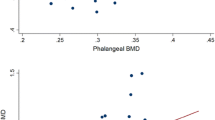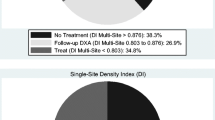Abstract:
Dual-energy X-ray absorptiometry (DXA) of the proximal femur and in more recent years quantitative ultrasound (QUS) of the heel are the most established methods for assessing hip fracture risk. Measurement of the fingers offers a new approach. We performed DXA of the proximal femur, QUS of the heel and fingers, and radiographic absorptiometry (RA) of the fingers in 87 non-institutionalized women, 65–85 years of age, with a first hip fracture and compared them with 195 randomly selected age-matched controls. Bone mineral density (BMD) of the femoral neck and heel Stiffness Index were significantly lower among cases than among controls (by 15% and 17%, respectively; p<0.0001), whereas no significant differences were found for finger measurements. When applying the WHO criterion of osteoporosis, 62–98% of the patients were classified as osteoporotic, compared with 19–85% of the controls, depending on method and site. The risks of hip fracture, estimated as odds ratios for every 1 SD reduction in femoral neck BMD, heel Stiffness Index, finger QUS and finger RA, were: 3.6 (95% CI 2.4–5.5), 3.4 (95% CI 2.2–5.0), 1.0 (95% CI 0.7–1.3) and 1.2 (95% CI 0.8–1.6), respectively. Compared with women with normal BMD of the femoral neck, those classified as osteopenic had an odds ratio of hip fracture of 14 (95% CI 2-110), whereas those classified as osteoporotic had an odds ratio of 63 (95% CI 8–501). We conclude that hip DXA and heel QUS have similar capacities to discriminate the risk of a first hip fracture, whereas QUS and RA of the phalanges seem inferior techniques for differentiating female hip fracture patients from controls.
Similar content being viewed by others
Author information
Authors and Affiliations
Additional information
Received: 10 March 2000 / Accepted: 21 September 2000
Rights and permissions
About this article
Cite this article
Ekman, A., Michaëlsson, K., Petrén-Mallmin, M. et al. DXA of the Hip and Heel Ultrasound but not Densitometry of the Fingers Can Discriminate Female Hip Fracture Patients from Controls: A Comparison Between Four Different Methods . Osteoporos Int 12, 185–191 (2001). https://doi.org/10.1007/s001980170128
Issue Date:
DOI: https://doi.org/10.1007/s001980170128




